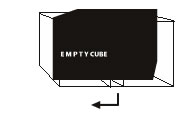JOÃO SEGURO
OCTOBER, 25, 2007

CONTACT
segurojoao@gmail.com
EXHIBITION INFORMATION
OUT OF THE CORNER OF THE EYE
SEM TÍTULO / UNTITLED (CASTING OUT NINES), 2008
Prova cromogénea,
6 partes, 23 x 29,5 cm cada
UNTITLED (SPLIT SCREEN), 2008
Madeiras, plinto, vidro pintado,
150 x 150 x 60 cm
Looking again.
This project began with an invitation I directed towards João Seguro to exhibit his work in a specific location. The space, formerly a contemporary art gallery, had a distinctive feature, its window display. Currently, this transparent window is no longer available to the audience. Covered, it no longer exerts an influence on the three metre cube that houses the artist’s project.
OUT OF THE CORNER OF THE EYE, a proposal that despite its finished and constructed appearance, is profoundly experimental in its approach, which is to say, in the conspicuous relationship it establishes with space. João Seguro correlates Art History, and by extension, the history of representation, with perception of space and the design it imposes on us. Seguro’s installation is comprised of two works, executed on different supports: one a series of six photographs, the other a sculpture. In both works, the artist tries the mechanisms of perception as well as our awareness, our bodily or physical recognition of its limits. Within Seguro’s work, the viewer’s gaze and presence conditions the work to such an effect that he or she wrestles with space and his or her actions therein.
In the series of photographs presented, Seguro subtly discloses the nature of his work process, where he pursues something that is not only of interest to him, but also to another, earlier artist, Bas Jan Ader i. In a particular piece comprised of six vertically hung photographs, produced by the Dutch artist in 1972, Ader portrays himself sipping a cup of tea beneath the shelter of wooden box, a tent of sorts which appears to have been propped up by a plank within a wooded area. Initially thoughts of Edouard Manet’s Le déjeuner sur l’herbe come to mind when regarding Untitled (Tea Party), but there is something to this work that shifts it from mere reference to painting, and this painting in particular. The position of the wooden pole that sustains the box is unstable, as unstable as a trap for hunting deer. On the other hand, the photographs are actually frames from a film directed by Ader. The work João Seguro presents, Casting Out Nines, like Ader’s original piece, is also comprised of six photographs ii. Here, Seguro represents a white geometric figure, positioned in a landscape with a background of verdant shrubs. The sequence of images dislocates the object from the background to the foreground, transforming it into another object altogether. Not only does the depth of field change, but so does the suggestion of filmic temporality. Although the point of view remains unaltered, the transition that our spectatorial gaze is subject to, before arriving at the foreground, blurs the direction of our reading of this sequence. What we initially determine to be a white panel (possibly a white canvas) is ultimately a three-dimensional figure, adjusted on a small wedge of wood that elevates it from the ground. João Seguro impresses a disruptive and tensional strategy to this work by testing the possibilities of the object’s representation, its referent, but above all, by questioning the way we project this object onto the images we see. Seguro’s proposal becomes even more radical with Split Screen, a sculpture that occupies the room to such an effect that almost all motion around the piece is eliminated, and as such, the possibility of observing it from different angles. This is perhaps Seguro’s greatest gimmick. The sculpture, despite its apparent presence - the pedestal we take to be the work - is not the pedestal as such, but its interior. Seguro beckons art history once more by way of the obliqueness established between the pedestal and the work. In the wake of Rodin, Brancusi or Robert Morris, Seguro deals with space and the actual physicality of the sculptural object, integrating language as a transformative procedure. The title of the work as such, counters the experience of the viewer and the sculpture meeting in space iii. Like Rodin and his Monument to Balzac, sculpture and base belong to the same category. But Seguro’s work presents another unexpected plane, one closer to utopian desire. The floor where his two-fold piece rests expands by way of a mirror that discloses another moment of observation and inner projection. This piece is a possibility, a proposal that beckons viewer participation, physical enactment and spatial awareness. The wedge that supports the box where Bas Jan Ader once sipped at his tea is a metaphor for the fall that we are all submitted to when confronting João Seguro’s operative strategy that connects us, if only momentarily, to the world he projects in front of our eyes. It is at this point that we are obliged to look again.
João Silvério,
October of 2007
----------------------------------
i João Seguro explores and demonstrates an interest not only in this box one might refer to as a “cube”, a parallelepiped or container, but essentially in the fact that this form, like any other, can be the site of an infinite number of actions and interventions that in nothing changes its shape, but only its function as an object in the visual field.
ii Seguro’s images, unlike Ader’s, are hung in a horizontal line. Whereas Ader’s choice draws these images closer to cinema and the vertical succession of photograms in film, Seguro’s choice brings the succession closer to the realm of video.
iii Split Screen refers to a motion picture technique whereby the viewer is given the opportunity to see several shots (in this particular case, two shots) of the same image at the same time.




